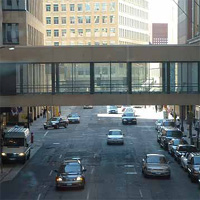Subway and Skyway System: Sustainable Infrastructure for Walking?
Abstract
The paper focuses on a peculiar typology of walking infrastructure: pedestrian subway/skyway systems. These infrastructure for the pedestrian mobility are Climate Controlled Walkway [CCW] networks made by pedestrian bridges or tunnels linking buildings, which allow pedestrians to move without using city streets and offer advantages to urban pedestrians. Prominent examples are the tunnel systems of Montreal and Toronto, the mixed tunnel/skywalk systems of Houston and Dallas, the skywalk systems of Minneapolis, Calgary and Cincinnati. The paper report some result of a comparative analysis of 19 study cases and define the main characteristic subways and skyways system where the pedestrian flows are completely separated from the vehicular traffic. The strengths are mainly related to the protection to pedestrian from weather and crime, the separation from vehicle traffic, the retails attractiveness in central business district,the reduction of car use in central areas, low maintenance costs for public authority. The weaknesses are low quality of street life, private management of the spaces and lack of orientation in the pedestrian network. Despite the success of some study cases, is still necessary to ask if these kind of pedestrian network are a sustainable solution for walking in city areas and what is the role of urban and transportation planning in order to minimize the negative effects of these practices.Downloads
References
Barker M.B (1986) Toronto’s Underground Pedestrian System, Tunnelling and Underground Space Technology, Vol. l, No. 2, pp. 145-151.
Bélanger P. (2007) Underground landscape: The urbanism and infrastructure of Toronto’s downtown pedestrian network, Tunnelling and Underground Space Technology Vol. 22, pp. 272–292.
Boivin D.J. (1991) Montreal’s Underground Network: A Study of the Downtown Pedestrian System, in Tunnelling and Underground Space Technology, Vol.6, N. 1, pp. 83-91.
City of Calgary (1984) +15 policy, Planning & Building Department.
Prompt (2005) New Means to promote Pedestrian Traffic in Cities – (http:// prompt.vtt.fi).
Geneve Service d’Urbanisme (2005) Plan directeur des chemins pour piéton.
Hass-Klau (1990) The Pedestrian and City Traffic. Belhaven Press, London.
International Walking Charter (2006) Walk21 (www.walk21.com).
Jacobs J. (1961) The Death and Life of Great American Cities, New York, Vintage Books.
Litman T. (1998) Whose Roads?, Victoria Transport Policy Institute (www.vtpi.org).
Pilon B. (1980) Les Halles Redevelopment: In Paris, a ‘City Center’ Goes Underground Underground Space.
Robertson K. A. (1994) Pedestrian malls and skywalks: traffic separation strategies in American downtowns. Avebury press, London.
Robertson K. A. (1993) Pedestrianization Strategies for Downtown Planners: Skywalks versus Pedestrian Malls Journal of the American Planning Association, Vol. 59.
Transport for London (2004) Walking Plan for London – LWP .
Yang Perry Pei-Ju (2005) From central Business district to new downtown: designing future sustainable urban forms in Singapore, in Michael Jenks, Nicola Dempsey (eds) Future Forms and Design for Sustainable Cities, Elsevier.

Copyright (c) 2014 Tema. Journal of Land Use, Mobility and Environment

This work is licensed under a Creative Commons Attribution 4.0 International License.
Authors who publish in this journal agree to the following:
1. Authors retain the rights to their work and give in to the journal the right of first publication of the work simultaneously licensed under a Creative Commons License - Attribution that allows others to share the work indicating the authorship and the initial publication in this journal.
2. Authors can adhere to other agreements of non-exclusive license for the distribution of the published version of the work (ex. To deposit it in an institutional repository or to publish it in a monography), provided to indicate that the document was first published in this journal.
3. Authors can distribute their work online (ex. In institutional repositories or in their website) prior to and during the submission process, as it can lead to productive exchanges and it can increase the quotations of the published work (See The Effect of Open Access)
